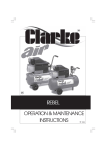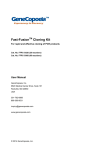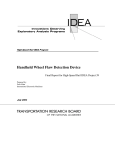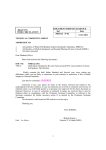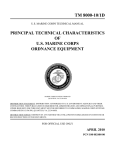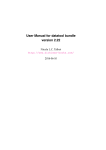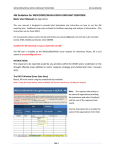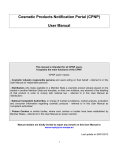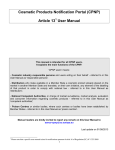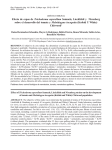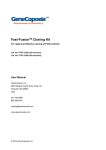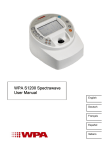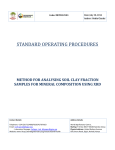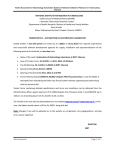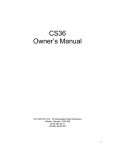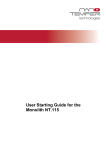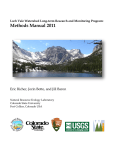Download Test Waters
Transcript
Household water treatment : Risk based approach and testing guidelines in India Pawan Labhasetwar Scientist & Head, Water Technology & Management Division NEERI, Nagpur, India WHO Collaborating Centre for Water and Sanitation Outline 1. Introduction 2. Risk based approach 3. Standards and evaluation Guidelines for HWT Units 4. Conclusion Common Indian’s habits & perceptions around drinking water - a cause of worry Is the same water used for bathing /washing clothes and drinking? Do you filter water before drinking? No, 85% Yes, 15% Source: Tata Chemicals Limited, 2008 From where do you get the water that you use for drinking? Well /tube well, 54% Lake /Pond, 3% Supply water /Govt provided; 26% Others, 17% Yes, 69% No, 31% How clean is your drinking water? Clean, 57% Not fit, 5% OK, 27% Very Clean, 11% Marginal penetration of water purifiers % penetration in urban households Water purifiers have the lowest penetration among durables Ignorance Lack of Motivation Confusion with existing technologies Affordability Source: IRS 2008, Urban penetration across SECs Water Supply System Elements Extraction Treatment Watershed Storage Distribution Households Water meter HAZARD SOURCES Total of 56 Catchment 18 SURFACE WATER 9 Treatment Plant S 8 Distribution 21 Source: WSP, Nagpur Average FC Count At Different Locations From Source to P‐O‐U 90 80 CFU/100ml 70 60 50 40 30 20 10 0 Sanitary Survey at Select Households A yes answer is interpreted as a risk Question asked : Yes answer Is storage design for dipping: 88% Do they use dipper with short/no handle: 67% Is the vessel accessible for children: 58% Do they pour back excessive water: 43% Is the vessel made of non-durable material: 33% Do they lack lid on storage vessel: 17% Is the inside of the vessel hard to clean: 13% Are there signs of dirt around opening: 11% The three most common risks are : 1. Storage designed for dipping 2. Use of short/no handle or hand for extraction 3. Storage vessels accessible for children. Microbiological contaminants reduction criteria (standards) using risk based approach • US EPA was the first regulatory body to adopt microbiological pathogen reduction targets for HWTS • Could be rendered safe if the HWTS was to deliver a – 6-log10 reduction of bacteria – 4-log10 reduction of viruses – 3-log10 reduction of parasitic cysts • WHO in 2011 published a new tiered system of microbiological reduction criteria Bureau of Indian Standards (BIS) • Bureau of Indian Standards, empowered through a legislative Act of the Indian Parliament, known as the Bureau of Indian Standards Act, 1986, • Operates a product certification scheme, and has till date granted more than 33000 licences • BIS product certification scheme is essentially voluntary in nature, and is largely based on ISO Guide 28 • Finances of the BIS are self managed, with certification operations accounting for more than 90% of the revenue Microbiological Standards for Point-of-Use Water Treatment Units (Draft) SCOPE Domestic/or household use (up to 100 litre /day) based on: • Exclusion technologies using membranes or other filtration materials, • Halogens and Halogenated resins, • Adsorption technologies such as modified materials, • Combination technology. Sampling plan for P-O-U system • Collect two samples of P-O-U systems from the same batch • Follow the installation procedure as per instruction manual • Allow at least 10 litres of product water (in line) or 1 volume equivalent of storage tank to flow and then collect the sample • While collecting influent challenge water, sampling point is just before the entry into the product • Manufacturer shall standardize the sequence of contaminants into influent challenge water to avoid precipitation. Performance evaluation test • At the minimum, three identical complete systems to be used for the evaluation • Challenging the system with the target microorganisms according to Standard Procedures • Repeating the challenge(s) at a predetermined frequency • Determining the reduction in the target microorganism numbers and expressing these in terms of log-reduction achieved Physical performance test Leakage test :Those portion of the purifier through which water passes, should be checked hydrostatically at a pressure 1.5 times of the pressure the purifier is designed for. For routine test however, device can be tested pneumatically at pressure of 0.196 MPa. Maximum rate of flow : Volume of output is measured in a calibrated volumetric measure for a specific period of time measured by a stop watch. Pressure for this experiment should be maintained within 5% of the maximum pressure declared by the manufacturer. Labeling • • • • • Brand name Production serial no. Model no. / code Production Rate in l/h Life of Water Treatment System/ Consumable (if applicable) • Technology Classification (Exclusion/ Halogen/ Adsorption) • Minimum upstream head (Hmin) (Applicable for Inline) • Maximum upstream head (H max) (Applicable for Inline) Challenge microorganisms • Bacteria - Klebsiella terrigena • Viruses - MS2 Phage • Protozoa – Cryptosporidium parvum oocysts Unit as a whole should achieve • 6 log reduction of bacteria • 4 log reduction of virus • 3 log reduction of cyst Test water characteristics • • • • • • Free from chlorine and disinfectant pH 6.5 to 8.5 Total organic carbon 0.5 mg/L Turbidity 1.0 NTU Temperature 20 ± 5°C Total Dissolved Solids 500 mg/L± 50 mg/L Sample Collection Plan Test Points Conditioning Cycle Water Passed 2 cycles or as recommended by manufacturer Sample None Start 1st Spike 2 cycles of spike water ** Influent & Effluent 0% to 25 % Life Test water None 25% 2 cycles of spike water Influent & Effluent 25% to 50% Test water None At 50% 2 cycles of spike water Influent & Effluent Stagnation 48 hrs None None After stagnation Test water Effluent 50% to 60% Test water None At 60% 2 cycles of spike water Influent & Effluent 60% to 75% Test water None At 75% 2 cycles of spike water Influent & Effluent Stagnation 48 hrs None None After stagnation Test water Effluent 75% to 100% Test water None At 100% 2 cycles of spike water Influent & Effluent Additional considerations for ensuring consumer safety • Consistency in removal effectiveness across the active lifetime of the technology • Consumer alert mechanism to enable the consumer to change or service the device and/ or components thereof on nearing exhaustion so that consumer can acquire the relevant materials and services in a timely manner • Material of construction and or active materials such as disinfectant should not leave residues or by-products in the finished water at levels that may be considered harmful for human consumption • Clear labeling/ communication that guides the consumer on the type of water that can be used with the HWTS, precautions, limitations, if any Conclusion • Microbiological performance criteria for HWTS have been developed by using risk based principles • Indian standards have single value for each microorganism • Important that necessary country level evaluation laboratories be developed • Consider data needs and formulate appropriate surveillance plans for determination of prevalence of pathogens and epidemiological significance to determine health targets • Also, additional consumer protection measures be integrated in HWTS propositions and addressed appropriately Thanks Test Waters: Conditioning/ test water: Potable tap water passed through carbon block/ cartridge, and therefore free from chlorine and disinfectant is to be used a test water. Confirm that the water does not have any adverse effect on survival of the test organism. Enumerate the viable counts (of spiked test organisms, e.g. 100cfu/ml of bacteria or 100 pfu/ ml of virus) after three hours exposure to test water and compare with saline control. This water is used during the pre-conditioning of the treatment device before subjecting it to challenge water. Preparation of Spike Water: • Add 2 ml of 0.01% Tween 20 to Crypto stock vial (10 ml containing 400000 of Cryptosporidium oocysts) or a microsphere working stock (equivalent to the number of spikes) and vortex to mix well. • Add the appropriate amount of stock to the test water (e.g. 15.0 ml (12.5ml Crypto+2.5 ml Tween) from Crypto stock vials for 10 L spike water). Wash the vials thrice with 0.01% Tween 20 followed by rinsing thrice with Distilled water. This will give the targeted spike of 50,000 Oocyst / L or 50,000 Microspheres/ L. • Mix well and keep a 100-ml sample of input water for analysis. • When more than one device is to be tested at the same time, combined spike water could be prepared. There will be one common Input sample for such testing. Sample collection and processing: Sample collection:• • Add spiked water in to the water purifier to be tested. Collect first two liters ( L 1 + L 2) in to a beaker* , sample out one liter aliquot and label as Output-1(O-1) • Collect next one liter (3rd liter) and discard. • Collect fourth & fifth liters (L 4 + L 5), sample out one liter aliquot and label as Output -2 (O-2). • Discard next liter (L-6) • Collect last two liters (L 7 + L 8), sample out one liter aliquot and label as Output -3 (O3). • The input water volume needs to be adjusted (considering the dead volume in the device) so that 8 L of output sample could be obtained. * for water purifiers working on chemical disinfection principle the output samples should be collected in beakers containing a suitable inactivation diluent in order to quench the disinfecting agent. Analysis Input sample and output samples must go through all the steps involved in analysis in identical manner. Sample number and type will be written on labels during all steps of processing. Output samples: • • • • • • • • • • Filter 500 ml of output water sample through the 47 mm, 0.8m ATTP (Isopore membrane) filter. The sample size should be such that the final slide will have between 20-200 oocysts. Give repeated rinse washes to the filtration assembly funnel with 0.01% Tween20 followed by distilled water. All the three samples could be combined and passed through a single membrane filter sequentially. Alternately, 100 ml from each of the three samples could be directly passed through 25 mm HTBP membrane filter, and proceed for staining (in case of oocysts) or counting (in case of pre-stained microspheres). Transfer the membrane to a 50-ml PP centrifuge tube. Add 8-ml elution buffer and shake on Griffin shaker at 600 oscillations per min for three minutes. Carefully transfer the buffer in to another 50-ml centrifuge tube (Tube 2) Oak Ridge tube Polycarbonate (Tarson’s) Repeat the elution procedure three more times and collect the pooled elution buffer in tube 2. Tube no 2 will have 32 ml pooled elution buffer from four elutions. Centrifuge the pooled elution buffer at 1390 x G (at 3410 rpm in SS34 rotor of Sorval RC-5 C centrifuge) at 10°C for 20 minutes. Pipette off supernatant to leave behind about 8 ml of sediment. Filter through 13 mm, 0.45 m HTBP (black Isopore membrane) filter using vacuum pump at 11 inches of Hg (0.4 bar). Rinse the tube repeatedly with 0.01%Tween and Distilled water. Stain the membrane as per procedure given with Stain Kit(BTF or Waterborne). Counts oocysts on the membrane using fluorescent microscope with 20X or 40x objective. (x 200- 400 magnification) Input Sample: • • • • • Assemble the membrane holder with 47-mm membrane and check that there is no leakage of water from the sides. Add about 500 ml distilled water and 5 ml** of Input / spike water sample in the funnel and mix well with the pipette tip. Rinse the pipette tip several times with 0.01% Tween 20 and distilled water. Apply vacuum and filter. Rinse the funnel with 0.01% Tween 20 and Distilled water. Process further identically as output samples. In case direct filtration on 25 mm filter was utilized for the output samples, filter 5 ml of the input directly on a 13 mm HTBP membrane and proceed for staining (for oocysts) or counting (for pre-stained microspheres) (** This sample size is to get 20-200 Oocysts on the final slide) Results and computation Record the Oocysts or microspheres on the slides of input and output samples and convert them into Oocystsor microspheres per liter of sample. The cyst removal expressed as log reduction is calculated asOocyst or microspheres log reduction = Log10 (value of oocysts or microspheres in input)/ L – log10(value of average oocyst or microspheres in output)/ L ((Count of oocysts or microspheres in O-1+ O-2+ O-3)*1000/ (total volume of sample tested O-1+ O-2+ O-3)). The microbiological water purifier must demonstrate 3 Log10reduction in Cryptosporidiumoocysts or Microspheres. Reporting Results : Report the results of the study in a table format clearly giving details of sample counts in influent and effluent, log values and log removal. Report shall conclude with final remarks on ‘conformance to microbiological reduction criteria and if not meeting the relevant log reductions be reported. The table format is given below Sample Litres of water passes ‘0’ Time 25% Life time 50% Lifetime 60% lifetime 75% lifetime 100% life time Influent log Effluent log Log NSF Log Remarks on removal reduction acceptance. criteria Test for inactivation based system for parasites This testing method is applicable for those technologies that claim reduction in parasite levels in drinking water by inactivation (e.g. uv and ozone based technologies). 1 Challenge (test) organism: Cryptosporidium parvum – live oocysts 2 Materials: 1) Cryptosporidium Oocyst suspension- Suspension of live Cryptosporidiumoocysts containing a minimum of 400,000 oocysts /10 ml. (BTF Precise Microbiology, Australia or Waterborne Inc, USA) 2) Reagents & their Preparation Stock Tween 20 (0.1%)Prepare a 0.1% stock solution of Tween 20 (Polysorbate 20) by dispersing 1ml Tween 20 in 900 ml DI water and make the volume to 1000 ml. Working solution of Tween 20 (0.01%)Dilute the stock of Tween 20, with DI water, 1:10, to get a working solution. 3) 4) • • • Eluting BufferLaureth 12 (Pall Pharma Product), To be used as such or 10% solution: - Weigh 10 g of Laureth 12 and dissolve in 90 ml DI water using Microwave oven or hot plate with low heating for about 2-3 minutes. Dispense 10-ml aliquots in sterile tubes and store at ambient (2 month use) or freezer. (12 month use) 1 M Tris, pH 7.4:- Dissolve 121.1 g Tris in 700 ml DI water, adjust the pH to 7.4 using 1 N NaOH / HCl. Make the volume to 1000 ml and store at 4-10 C. 0.5 M EDTA, pH 8.0:- Dissolve 186.1 g EDTA (disodium salt) in 800 ml DI water. While stirring add 20 g NaOH and increase the volume with water to 950 ml. Adjust pH to 8.0 using 1.0 M NaOH and make the volume to 1000 ml. Antifoam A (Sigma) or equivalent. Procedure for making the buffer Dissolve 1g Laureth 12 in 100 ml DI water using 150/250ml beaker by gentle heating and transfer in to 1000-ml volumetric flask. Rinse the beaker several times till shaking the water in the beaker generates no foam. (Or add 10 ml of 10% Laureth 12 to 1000 ml volumetric flask and rinse the pipette tip several times to transfer all the detergent.) Add 10 ml of 1.0 M Tris, p 7.4 and 2 ml of 0.5M EDTA, pH 8.0 and 150 l of antifoam A if required. Make the volume to 1000 ml with DI water. Stain Kit (BTF Precise Microbiology, Australia or Waterborne Inc, USA) Fluorescent antibody staining kit containing a) stain b) Wash buffer c) Positive control and d) Mounting Medium. Millipore Membrane filters: 0.8 µm ATTP (47 mm) and 0.4 µm HTBP (13 mm or 25 mm). Formaldehyde (37 %) 3% H2O2 Tween 80 CONTAMINATION AT HOUSEHOLD LEVEL • In a number of developing countries lack of 24x7 piped water • Households therefore need to resort to water storage for all domestic needs including for drinking • Storage of water in compromised environmental settings leads to heightened risk of microbiological contamination Hazards & Handling: • • • • • • • • • • • • • • Avoid exposure to the water samples containing oocysts. Part of the procedure needs to be carried out in a Biosafety hood and in a restricted entry lab by personnel trained in handling microorganisms. Appropriate personal protective equipment (Gloves, safety shoes, safety goggles, lab coat, and face mask) should be worn while handling live organisms. Take proper precautions to dispose off the samples / effluent arising of the test protocol- Cryptosporidium could be inactivated by exposure to formaldehyde and/ or autoclaved prior to disposal. All disposable material (gloves, shoe covers, face mask, head cover) need to be autoclaved prior to disposal. Any spillage should be promptly treated with 10% formol saline (formaldehyde plus saline) or 5% ammonia, or 3% H2O2 for 18h prior to disposal. Steam sterilization is recommended. Heating at 65°C for 30 min reduces oocyst infectivity. Oocyst may survive for 2 to 6 months in a moist environment. The biohazard associated with, and the risk of infection from oocysts is high in this methodbecause live organisms are handled. This method tries to address the safety problems associated with its use. It is important to establish appropriate safety and health practices prior to the use of this method. The analyst/technician must know and observe thesafety procedures required in a microbiology laboratory that handles pathogenic organisms while preparing, using, and disposing of sample concentrates, reagents, and materials, and while operating sterilization equipment. Each chemical compound should be treated as a potential health hazard and handled appropriately. Exposureto these compounds should be reduced to the lowest possible level. Safe handling of the chemicals specified in this method should be practiced. A reference file of material safetydata sheets must be made available to all personnel involved in these analyses. Samples may contain high concentrations of biohazards and toxic compounds and must be handled with gloves and opened in a biological safety cabinet to prevent exposure. Reference materials and standards containing oocysts must be handled with gloves and the personnel must never place gloves in or near the face after exposure to solutions known or suspected to contain oocysts. DONOT MOUTH PIPETTE. Laboratory personnel must change gloves after handling filters and other equipment and reagents that may be contaminated. Gloves must be removed or changed before touching any other laboratory surfaces or equipment. In case of spillage, promptly clean with 3% H2O2 and allow for exposure of 18h before disposal. Autoclaving is recommended prior to disposal of any material. Preparation of Spike Water: • • • • Add 2 ml of 0.01% Tween to Easy seed vial (10 ml containing 400000 of Cryptosporidiumoocysts) and vortex to mix well. Add the appropriate amount of stock to the test water (e.g. 15.0 ml (12.5ml Crypto+2.5 ml Tween) from Crypto stock vials for 10 L spike water). Wash the vials thrice with 0.01% Tween 20 followed by rinsing thrice with Distilled water. This will give the targeted spike of 50,000 Oocyst / L Mix well and keep 100-ml sample of input water for analysis. When more than one device is to be tested at the same time, combined spike water could be prepared. There will be one common Input sample for such testing. Sample collection and processing Sample collection: • Add spiked water in to the water purifier to be tested. • Collect first two liters (L 1 + L 2) in to a beaker*, sample out one liter aliquot and label as Output-1(O-1). • Collect next one liter (3rd liter) and discard. • Collect fourth & fifth liters (L 4 + L 5), sample out one liter aliquot and label as Output -2 (O-2). • Discard next liter (L-6) • Collect last two liters (L 7 + L 8), sample out one liter aliquot and label as Output -3 (O-3). • The input water volume needs to be adjusted (considering the dead volume in the device) so that 8 L of output sample could be obtained. * for water purifiers working on chemical disinfection principle the output samples should be collected in beakers containing a suitable inactivation diluent in order to quench the disinfecting agent. Analysis Input sample and output samples must go through all the steps involved in analysis in identical manner. Sample number and type will be written on labels during all steps of processing. Output samples: • • • • • • • • • • • Filter 500 ml of output water sample through the 47 mm, 0.8m ATTP (Isopore membrane) filter. The sample size should be such that the final slide will have between 20-200 oocysts. Give repeated rinse washes to the filtration assembly funnel with 0.01% Tween20 followed by distilled water. All the three samples could be combined and passed through a single membrane filter sequentially. Alternately, 100 ml from each of the three samples could be directly passed through 25 mm HTBP membrane filter, and proceed for staining (in case of oocysts) or counting (in case of pre-stained microspheres). Transfer the membrane to a 50-ml PP centrifuge tube. Add 8-ml elution buffer and shake on Griffin shaker at 600 oscillations per min for three minutes. Carefully transfer the buffer in to another 50-ml centrifuge tube (Tube 2) Oak Ridge tube Polycarbonate (Tarson’s) Repeat the elution procedure three more times and collect the pooled elution buffer in tube 2. Tube no 2 will have 32 ml pooled elution buffer from four elutions. Centrifuge the pooled elution buffer at 1390 x G (at 3410 rpm in SS34 rotor of Sorval RC-5 C centrifuge) at 10°C for 20 minutes. Pipette off supernatant to leave behind about 8 ml of sediment. Filter through 13 mm, 0.45 m HTBP black isopore membrane filter using vacuum pump at 11 inches of Hg (0.4 bar). Rinse the tube repeatedly with 0.01%Tween and Distilled water. Stain the membrane in the following manner : Add 100 µl of Propidium iodide (stock – 100 µg/ml) and incubate at 37°C for 20 mins in a humid chamber. Destain the membrane by adding 120 µl of wash buffer (or HBSS) for 1 min. Add 100 µl of 4',6-diamidino-2-phenylindole (DAPI- Stock- 2mg/ml in absolute methanol) and 100 µl of FITC tagged antibody stain (BTF or Waterborne). Incubate the assemblies at 37°C in a humid chamber for 30 mins .Wash with 120 µl of wash buffer (or HBSS) for 1 min. Using vacuum, remove the wash buffer as far as possible. Load the membrane on a glass slide for counting. Counts oocysts on the membrane using fluorescent microscope under 20X or 40x objective (x 200-400 magnification) with a UV filter block for FITC, DAPI and PI. ( Ex/ Em for FITC: 495 nm/ 521 nm, DAPI: 358 nm/ 461 nm, and PI: 488 nm/ 562 nm) . Count oocyst which appear red (with inclusion of PI) as dead cyst. Count number of apple green colored cyst (FITC antibody stained) under UV Filter as total cysts. Count the light blue colored cyst (DAPI +) as viable cyst. (DAPI may be necessary as sometimes, FITC stained antibody may pick up empty oocyst structures that may not be counted as live or dead). Input Sample: • • • • • Assemble the membrane holder with 47-mm membrane and check that there is no leakage of water from the sides. Add about 500 ml distilled water and 5 ml** of Input / spike water sample in the funnel and mix well with the pipette tip. Rinse the pipette tip several times with 0.01% Tween 20 and distilled water. Apply vacuum and filter. Rinse the funnel with 0.01% Tween 20 and Distilled water. Process further identically as output samples. In case direct filtration on 25 mm filter was utilized for the output samples, filter 5 ml of the input directly on a 13 mm HTBP membrane and proceed for staining. (** This sample size is to get 20-200 Oocysts on the final slide) Results and computation Record the Oocystson the slides of input and output samples and convert them into Oocystsper liter of sample. Live cyst reduction can be calculated by subtracting the number of live cysts of output/L from live cyst of input/L The oocystinactivation is expressed as log reduction and is calculated asLive Oocystlog reduction = Log10 (value of live oocystsin input)/ L – log10(value of average live oocystin output)/ L. [(Count of live oocysts in O-1+ O-2+ O-3)*1000/ (total volume of sample tested O-1+ O-2+ O-3)]. The microbiological water purifier must demonstrate 3 Log10 reduction in the viability of Cryptosporidiumparvumoocysts. REFERENCES : 1. NSF Protocol P231: Microbiological Water Purifiers (2003) 2. NSF/ANSI S53 –2007. Drinking Water Treatment Units – Health Effects (2007) 3. EPA/NSF ETV: PROTOCOL FOR EQUIPMENT VERIFICATION TESTING FOR INACTIVATION OF MICROBIOLOGICAL CONTAMINANTS (2003) REFERENCES The following Indian standards contain provisions, which, through reference in this text, constitute provision of this standard. At the time of publication, the editions indicated were valid. All standards are subject to revision, and parties to agreements based on this standard are encouraged to investigate the possibility of applying the most recent editions of the standards indicated below. IS10500 Drinking water specification(Second revision) IS 302: Part 1: 1979 Safety of household and similar electrical appliances: Part 1- General requirement” (5th revision) IS 3025: Part 10:1984 Method of sampling and test (physical and chemical) for water and waste water part 10: - Turbidity” (first revision) IS 3025: Part 25: 1986 Methods of sampling and test (physical and chemical) for water and wastewater: Part 25 Chlorine, demand” (first revision) IS 14724: 1999 Ultraviolet water disinfection system - Specification IS9845:1998 Determination of overall migration of constituents of plastics material and articles intended to come in contact with foodstuffs – Method of analysis” APHA, Standard Methods for the Examination of Water and Wastewater, 21st edition. EPA (Environmental Protection Agency) methods for the analysis of water NSF P231, Microbiological Water Purifiers NSF/ANSI 53, Drinking Water Treatment Units- Health Effects NSF/ANSI 60 Drinking water treatment chemicals – Health effects NSF/ANSI 61 Drinking water system components – Health effects NSF/ANSI 42 Drinking water treatment units – Aesthetic effects Managing Water in the Home World Health Organization, Geneva, WHO/SDE/WSH/02.07 Accelerated Health Gains from Improved Water Supply - Water, Sanitation and Health, Department of Protection of the Human Environment WHO Evaluating Household Treatment Options (2011) WHO Guidelines for Drinking Water Quality (2011) TERMINOLOGY For the purpose of this standard the following definitions shall apply – Membrane:-A semi-permeable barrier that allows preferential passage of water. Commonly used reverse osmosis membranes include cellulose triacetate and aromatic polyamide polymers popularly known as TFC (thin film composites). – Ultra-filtration (UF):- A technology that excludes micro-organisms by virtue of low porosity of membrane – Drinking water:-Water intended for human consumption for drinking and cooking purposes from any source (Refer IS: 10500 drinking water specification). – Production rate:- The volume of water produced by a system in litres per hour – Point of use drinking water treatment system:- A plumbed-in, or gravity-based pour through system used to treat the feed water – Feed water:-Water entering the system. – Product water:-Water that has been treated by a system. – Influent challenge level:-The standard test water with specified contaminants entering a system for evaluation. Construction Common requirements Alert system :Device should have a mechanism that will alert consumers of either “End of Life” / OR “Near End of Life” so that the relevant consumable part of the device can be changed/ serviced. Standard to be Complied with: Chemical residues/ disinfectant by-products, if any contributed by the technology, into the output water should meet the limits specified in the standard for Drinking Water IS 10500 or any other global safety regulation such as WHO/ US EPA Common components The MWTS may be equipped with at least one or more of the following common (technology independent) components a. b. c. d. e. f. Pre-filter system (e.g. Sediment Filter , Carbon filter) Suitable material / part to adsorb/ remove residual disinfection by-products Storage chambers (for Input water and Treated water) as applicable Flow indication For Inline systems: Wall mounting provision or Table top provision For Gravity/ pour through : Table Top provision For Exclusion technologies The basic technology involves exclusion of microbial contaminants by use of membranes viz Micro-filtration membrane or Ultra-filtration membranes. This can be used individually or in combination technology to achieve desired microbial contaminant removal. For MWTS based on halogen and halogenated resin technologies Halogen-based disinfectants are the most common disinfectants used today and find applications ranging from water treatment at large municipal facilities to in-home water treatment. Disinfectants are added to inactivate or kill pathogens, the extent of disinfection determined by the pathogen’s sensitivity to a particular disinfectant, the concentration of the disinfectant (C) and the exposure time (T). Bromine- and iodine-based disinfectants have also found applications in traditional in-home drinking water treatment either through direct addition or in the form of impregnated controlled-dose resins. Chlorine dioxide is another key disinfectant that has been used for water treatment. Disinfection by-products (DBPs) - appropriate provisions to prevent formation of DBPs or excluding them from the finished water must be made in such MWTS. A In addition provisions must exist to reduce the residual halogen in the finished water to acceptable (health) levels (IS 10500). It is also known that different pathogens vary in their sensitivity to disinfectants, with some pathogens being resistant to halogens. In order to be effective in addressing all types of pathogens, halogen-based technologies are usually complemented with other technologies (e.g. exclusion). Halogen-based technologies could deliver the halogen active by dissolution of a compound that releases halogen when in contact with water. In such cases, the output water collected immediately after release from the halogen source could be analyzed for presence/ estimation of the halogen. In case a halogenated resin is used, the output water immediately post the resin may be collected and the level of the halogen determined. Alternately, if the resin is accessible, the halogen could be extracted from crushed or dissolved beads and measured. In general resins are available with minimum 5% halogen loading. Adsorption Technology A number of new technical options based on materials that actively adsorb or trap microorganism on the surfaces of particles are now available. Carbon coated with nanofibres, materials coated with poly-valent cations that capture anionic microorganisms have been reportedly used for treating drinking water. Combination Technology Each of the above principles of addressing removal of pathogens have specific limitations either inherent (e.g. comparatively lower effectiveness of halogens to address certain parasites) or relating to engineering parameters such as flow rate (e.g. adsorption of virus on polyvalent materials may be compromised in high flow rate configurations). To overcome the limitations of individual technologies, it is increasingly becoming common for manufacturers to provide multiple barriers by combining two or more of the above principles in their devices to ensure that the treated water is free from waterborne pathogens. For MWTS based on Exclusion technologies using membrane as exclusion media Molecular weight cut-off (MWCO) Test by gamma globulin method : The protein, named r-globulin, that has molecular weight of 156000 is dissolved to 100 ppm of concentration and pass through small test membrane module. The concentration change result from membrane permeation is used to estimate virus rejection rate. The retention should be minimum 70% to achieve 4 log virus rejection. Membrane integrity test: The air particle test is done for every module produced. The membrane has no defect did not pass through 0.3 micron air borne particles. (particles always exist in ambient air used) The principle is based on air borne particle larger than 0.3 micron is completely removed by UF membrane. If there is only one fiber breakage, or potting error the 0.3 micron air borne particle pass through the UF membrane and can be detected such defects by means of air particle counter. This method is non-destructive and very efficient method to detect defects of membrane if the membrane has sufficient air permeability.(usually at least 2L/min of air flow rate needed). For MWTS based on halogen and halogenated resin technologies Halogen concentration (in treated water) and Residual halogen (in treated/ finished water): The level of residual halogen in the output water could be titrated to ensure that the levels are within the maximum prescribed in the BIS standard IS 10500. Disinfection- and Disinfectant-by products: The formation and levels of these by-products in the output water needs to be controlled using the appropriate technology. The limits for these are regularly updated and available in the WHO guidance document (http://www.who.int/water_sanitation_health/publications/2011/97892 41548151_ch08.pdf, Table 8.16) Adsorption technology Testing method: Note: Usually the Adsorption technology in MWTS, are specific and proprietary to the Manufacturer and he may suggest a suitable testing method for their performance. In general, the performance criteria is the testing of bacteria, virus and cyst removal using standard protocol (Ref. same mentioned in the draft annexure 1). The device should be capable of filtering at least 10L water per day for domestic household consumption. These purifiers are suitable for domestic use and are driven either by gravity or pressurized system available in the public water supply line without the use of electricity. Combination Technology Testing specification and methodology will depend on the selected combination of technologies. The manufacturer shall select the appropriate specifications as mentioned above, basis the technology used in the MWTS. EFFICACY TESTING OF WATER Klebsiellaterrigena& MS2 Bacteriophage PURIFIER FOR THE REDUCTION OF Bacteria : Klebsiellaterrigena, a common coliform is used as a challenge organism to represent the coliform group. It is commonly found in surface watersand some members of this genus are potential pathogens for humans Polluted water streams generally contain about 105organisms per 100ml therefore a 6 log reduction is recommended (99.9999%), with a log higher input load as a challenge to the system. Performance of a purification device could be tested by spiking the device with a known load and checking the bacterial removal per 100ml in the output water. The removal is calculated as the difference in log value of the input and log value of the output and is expressed as reduction number log10. • • • • For any given instance during the lifetime of the purification device/ system, if performance has to be evaluated then this standard procedure needs to be followed, so that the results obtained are solely representative of the performance. The protocol apparently reduces any variations, if by chance introduced any time during testing while the experimental conditions remain the same. The device must demonstrate 6 log10/100 ml reductions in bacteria for 90% of all the challenges with not less than 5-log bacterial removal for the remaining 10%. The tests are performed on complete and intact purification devices/system. The device needs to be re-spiked if the input counts fall below 1 X106cfu/ 100 ml. Virus : Poliovirus and rotavirus represent two different families of enteric viruses, and they have been extensively studied in disinfection and environmental studies. The MS2 phage, a male- specific coliphage that possess an RNA genome, is similar to human enteroviruses in terms of size, structure and resistance characteristics to common disinfectants. It is a promising candidate indicator of human viruses in water as it does not replicate in the environment similar to human viruses. It is also a good test organism for devices (like UF) that reduce virus loads from water through filtration. (It cannot be used for MF device testing since the pore size of membrane is much bigger than that required for viral exclusion) The level of enteric viruses is estimated to be in the range from 103 – 104 per liter in raw sewage. Natural waters contaminated with untreated sewage may contain 101 to 102 per liter. Assuming a target effluent level of less than one virus in 100L of water and a conc. of 104 enteric viruses in 100 liters of contaminated waters, the purifier should achieve at least 4 log virus removal. Method : Bacterial Culture Maintenance & Preparation For Testing Purposes • • • • • • The Growth State of the test bacteria is critical as this affects sensitivity and resistance to disinfectants. Consequently, only bacteria in the stationary growth phase should be used. The test organism should be washed and suspended in sterile saline before addition to the challenge water. For this purpose, Klebsiellaterrigena ATCC 33257 is to be maintained on Trypticase Soy Agar (TSA) or NA slants and checked using Endo agar for purity. The culture is to be held frozen in glycerol containing media at –800C for a period of 6 months before it is revived & preserved again. (Inoculate a culture from plate or glycerol stock in 20 ml of TSB and incubate overnight on shaker at 37°C). The resultant suspension is to be recovered by centrifugation at 3000 x g for 10 minutes. The supernatant is to be discarded and the cells washed with sterile saline and resuspended in sterile saline. Adjust the culture density of this suspension, using spectrophotometer (appropriately blanked), to attain an OD600nm of 0.8 to 1.0 (~108 -109cfu). Add sufficient volume of this to the spike water to attain the desired seed value. Alternately, culture could be recovered from overnight plate directly in saline (taking care not to scrape out agar) and the OD adjusted to 0.8-1.0. MS-2 Bacteriophage Culture Maintenance & Preparation For Testing : Propagation of the Bacteriophage: • • • • • • • • • Prepare an actively growing broth culture (25 ml in a 100 ml sterile container) of the MS2 Host by inoculating loopful it into 25 ml of the medium under static and aerobic condition at 37C for 24 hr. Dilute this 1:100 into fresh broth and incubate for 2-3 hr at 37C under static conditions till the cell density reaches ~2-3 x 108cfu/ml (OD600nm ~ 0.3) Add MS2 phage stock at an m.o.i of 0.1 and leave under static conditions for 30 min at 37C to aid infection. After this, vigorously agitate the flask for 2-2.5 hr (240 rpm) at 37C to enable lysis of the infected cells. Visually this should be seen as a clearing in the medium followed by a marginal increase in the density as the uninfected non-pilus containing cells start growing. Add 1-2 drops of chloroform to lyse the bacterial cells and centrifuge at 10000 rpm in SS-34 tubes for 10 min at room temperature. Filter the supernatant through a sterile 0.22-micron filter and collect the filtrate in a sterile container. Leave it slightly open in a clean hood to evaporate the chloroform (till no odour remains) This is the MS2 stock. Quantify the number of viruses per ml and store at 4C (short term or at -20/-80°C for about 2-3 months). Quantification of the Bacteriophage• • • • • • • • • • • • Prepare an actively growing broth culture (25 ml in 100 ml sterile container) of the MS2 Host by inoculating loopful it into 25 ml of the medium under static and aerobic condition at 37C for 24 hr. Pour the basal agar plates with Escherichia Medium Agar and after they have set, transfer them to incubator maintained at 37C. (Maintenance of the plates at this temperature helps the soft agar to set properly without lumps, once it is poured on the top). Prepare tubes containing 3.5 ml soft agar and maintain them at ~45C (molten state), ready to be mixed with sample and host for plating over the basal medium. Serially dilute the stock (1:10 & 1:100 each time) up to 10-12 dilution (typically titre of between 10111012pfu/ml are expected if the yield is good). For each of the dilutions, pipette out 1 ml of the virus sample in the sugar tube with 3 ml soft agar maintained at ~45C and then add 250 µl of host culture. Vortex it slightly (just enough to mix all three) using the pipette itself (up and down movement avoid froth and bubble formation) and immediately pour it on the base agar. Alternately, 1 ml of the test sample is mixed with 250µl of the host on the basal plate and about 5-7 ml of the molten soft agar is poured and mixed. Allow the plates to set properly for at least an hour, before they are transferred to 37C incubator and incubated straight up (NOT INVERTED) for 18-24 hr. Count the number of plaques observed in each plate against a dark background. Calculate the numbers of viruses as pfu/ml. The stock prepared can be used for up to 3 months. Periodically check for loss in viability of the phage. Discard when levels drop by >1.5 log. The host culture & the phage lysate is to be held frozen in glycerol containing media at –800C for a period of 6 months before it is re-isolated & preserved again. Test Procedures: Conditioning: Install and condition a minimum of two units in accordance with manufacturer’s instructions. Use test water for two cycles of top chamber and measure and record the flow rate; confirm that it is as specified by the manufacturer. Drain out water from the top loading chamber as well as from the chamber collecting the final purified water. Challenge (spike) Cycles: Fill the top chamber completely after collecting adequate influent sample and run the device the normal way. Collect the effluent samples as specified below. The treatment device is to be challenged at six different time points during the lifetime study. They are a) b) c) d) e) f) Start of test. 25 % 50% 60% 75% 100%; End of life time. A stagnation period of 48 hours is given after completion of 50% and 75% life time. Cycles between the challenge spikes: The test water is passed through the treatment device during the period between two challenge spikes. Monitor the flow rate during the life time study and ensure that the flow rate does not drop below the desired rate(<50 ml/ min). Clean the filter if required in accordance with manufacturer’s instructions. The test plan giving spiking and sampling points is as below. USER MANUAL A user manual for the proper method of operation and use of the RO system shall be supplied along with the RO system. It shall also include the life and specification of all the filters/consumables. WARRANTY The manufacturer shall provide a suitable warranty CERTIFICATION MARKING: The product may also be marked with the BIS Standard Mark The use of the Standard Mark is governed by the provisions of the Bureau of Indian Standards Act, 1986 and the Rules and Regulations made there under. The details of conditions, under which the license for the use of Standard Mark may be granted to manufactures or producers, may be obtained from the Bureau of Indian Standards. PACKING: The product shall be suitably packed in order to avoid damage during transit and storage. • Influent and effluent samples shall be collected at different time points during the life time study as specified in the table above. At every sampling point, collect the Influent sample before loading it in the device. Collect the effluent sample at three points of the cycle; at the start of the second cycle from the 2ndlitre, from middle of cycle and from the penultimate litre of cycle. • Quantity of sample: All the samples will be collected in duplicate (2 X 100 ml) and stored under refrigeration at 410 C till they are analysed. The time between sample collection and analysis (plating) should not exceed three hours. An appropriate neutralizer (e.g. 10% sodium thioglycollate + 14% sodium thiosulfate, add 1 ml per 100 ml sample) could be added to samples to stop the active from reacting further. Enumeration of K. terrigena: Standard Membrane Filtration Method (for output samples only) – To establish a 6-log10 reduction, 100 ml of the effluent should be tested. – 100 ml of the sample is to be passed through a sterile 0.22-micron filter, which is then placed on a pre-poured Endo Agar plate and incubated at 37C for 24-48 hrs. This should be done in duplicate. The filtrate could be used for analysis of MS2. – If the input sample is determined to be 5 x 107/100 ml, the equipment passes if the count in the output is < 50 cfu / 100 ml. Standard Spread Plate Method. • • • • • • Prepare the serial dilution of the test sample in saline. Make serial dilition upto -2 for Output samples and upto -4 for input samples Put 0.1 ml of undiluted and -2 dilution of output sample on pre poured Endo agar plate and incubate at 37C for 24hrs. This should be done in duplicate. Put 0.1 ml of input sample, from the last two dilutions i.e. -3 and -4 on Endo agar plate. Appropriate positive control (plating neat K terrigena suspension) and negative controls (medium & saline controls) must be kept during each challenge experiment to eliminate errors due to problems occurring due to bacterial strain, media or diluent. All standard precautions to be followed for bacterial testing must be strictly adhered to. Enumeration of MS2 bacteriophage : • • • • • • • • • Analysis for MS2 is carried out using 1 ml sample (in duplicates) For the analysis, 1 ml of the sample is to be passed through a sterile 0.22 (or 0.45 if 0.22 is not available) micron filter, which is necessary to remove any sort of bacterial contamination introduced at any time during the experiment. For output samples alternately, the filtrate collected during the membrane filtration of 100ml output Prepare the serial dilution of the test sample in saline. Plate the undiluted and the prepared dilutions on base agar. In case of Input being established as 5 log/ml, a 4 log reduction should give no plaques in the -2 dilution Appropriate positive (spot assay for plaque formation) and negative controls (medium control, saline control) must be kept during each challenge experiment to eliminate errors due to problems occurring due to either strain/ media or diluent. The plates ready for incubation at 370C should not be inverted. Incubate overnight. All standard precautions to be followed for microbiological and especially viral testing must be strictly adhered to. Calculations : • The bacterial log reduction is calculated as given as follows- Input Load = ----cfu/100ml Log10 = ------Output Load = -----cfu/100ml Log10= -----Log10 Reduction= Log10 (Input) – Log10 (Output) • The virus log reduction is calculated as given as follows- Input Load = -----pfu/ml Log10 = ----Output Load = ------ pfu/ml Log10= -----Log10 Reduction= Log10 (Input) – Log10 (Output). Test for exclusion based systems for parasites 1 Challenge (test) organism: Inactivated Cryptosporidiumparvumoocysts (by irradiation or formalin treated) OR Polystyrene microspheres (3.0 µm size, >95%, fluorescent or non fluorescent beads) 2 Materials: 1) Cryptosporidium Oocyst suspension- Suspension of inactivated Cryptosporidiumoocysts containing a minimum of 400,000 oocysts /10 ml. (BTF Precise Microbiology, Australia or Waterborne Inc, USA) 2) Polystyrene microspheres: available at various concentrations from different vendors (egPolysciences) 3) Reagents & their Preparation Stock Tween 20 (0.1%)Prepare a 0.1% stock solution of Tween 20 (Polysorbate 20) by dispersing 1ml Tween 20 in 900 ml DI water and make the volume to 1000 ml. Working solution of Tween 20 (0.01%)Dilute the stock of Tween 20, with DI water, 1:10, to get a working solution. 4) Eluting Buffer• • • • Laureth 12 (Pall Pharma Product), To be used as such or 10% solution: - Weigh 10 g of Laureth 12 and dissolve in 90 ml DI water using Microwave oven or hot plate with low heating for about 2-3 minutes. Dispense 10-ml aliquots in sterile tubes and store at ambient (2 month use) or freezer. (12 month use) 1 M Tris, pH 7.4:- Dissolve 121.1 g Tris in 700 ml DI water, adjust the pH to 7.4 using 1 N NaOH / HCl. Make the volume to 1000 ml and store at 4-10 C. 0.5 M EDTA, pH 8.0 :- Dissolve 186.1 g EDTA (disodium salt) in 800 ml DI water. While stirring add 20 g NaOH and increase the volume with water to 950 ml. Adjust pH to 8.0 using 1.0 M NaOH and make the volume to 1000 ml. Antifoam A (Sigma) or equivalent. Procedure for making the buffer Dissolve 1g Laureth 12 in 100 ml DI water using 150/250ml beaker by gentle heating and transfer in to 1000-ml volumetric flask. Rinse the beaker several times till shaking the water in the beaker generates no foam. (Or add 10 ml of 10% Laureth 12 to 1000 ml volumetric flask and rinse the pipette tip several times to transfer all the detergent.) Add 10 ml of 1.0 M Tris, p 7.4 and 2 ml of 0.5M EDTA, pH 8.0 and 150 l of antifoam A if required. Make the volume to 1000 ml with DI water. 1 Stain Kit (BTF Precise Microbiology, Australia or Waterborne Inc, USA) -Fluorescent antibody staining kit containing a) stain b) Wash buffer c) Positive control and d) Mounting Medium 2 Millipore Membrane filters: 0.8 µm ATTP (47 mm) and 0.4 µm HTBP (13 mm or 25 mm) Reporting Results : Report the results of the study in a table format clearly giving details of sample counts in influent and effluent, log values and log removal. Report shall conclude with final remarks on ‘conformance to microbiological reduction criteria and if not meeting the relevant log reductions be reported. The table format is given below Sample Litres of water passes Influent log Effluent log Log NSF Log Remarks on removal reduction acceptance. criteria ‘0’ Time 25% Life time 50% Lifetime 60% lifetime 75% lifetime 100% life time Materials Materials in contact with water, including disinfectant containing water, shall not impart extractable contaminants exceeding the permissible level for various plastic materials when tested as per IS 9845:1998. Material of construction: Those surfaces of the components of the filtration system, which are expected to get wetted by the flow of water through the purifier, shall be made of resistant materials or shall have corrosion–resistant treatment or coating of food grade quality. The manufacturer shall provide an evidence of the same. All the components of the device that is exposed to water pressure must be able to sustain the maximum water pressure the device is designed for (as per the declaration of the manufacturer) [This maximum operating pressure should be clearly mentioned in the instruction manual]. The chemical preservatives or wetting agent, if used in the membrane, shall be of food grade quality and shall be declared by the manufacturer in the user manual for consumer. Routes to contamination Materials: Equipment and Accessories • • • • • • • Vortex mixer. Millipore vacuum pump. 0.22 µ sterile Millipore membrane filters (Millipore GSWP 04700). Millipore Filtration Assembly Sterile syringes and forceps. Pipettes 0.22 µ sterile Millipore membrane filter (Syringe Driven filters) Culture and Media : • • • • Klebsiella terrigena (ATCC 33257) suspensionThe level of bacteria per spike should be approximately ~5 x 107cfu/100ml, as a 7 log10 spike is required for determining 6 log10reduction. Sterile Endo Agar Sterile TSA / NA Sterile saline (0.85% NaCl)


































































